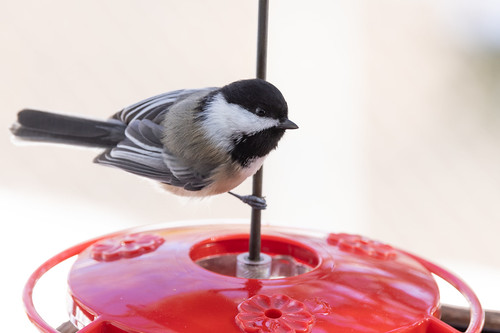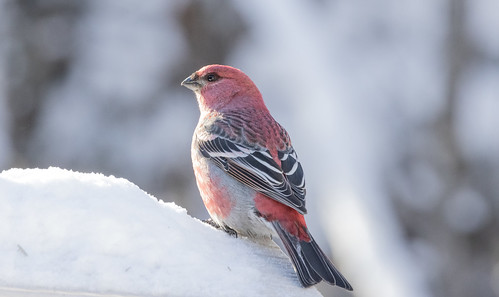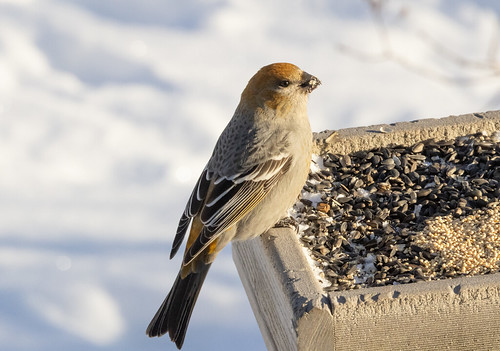Several listeners have sent me emails this week about backyard birds. John Siegworth writes from Wisconsin:
I have listened to your "For the Birds" show on WXPR for many years. I wondered if you could answer a question? We own a cabin in northern Wisconsin (Vilas county) and for years we have observed Canada Jays, primarily during the fall and winter months. They would frequently visit our suet feeders and would even take small slices of fruit/nut breads that we'd place on the deck railing. They sure were fun birds to watch!
Over the last few years these birds seem to have disappeared. In fact, I'd say it's been at least five years since our last sighting of a Canada Jay. Our fellow birding friends have also not observed these birds over this period of time. I'm wondering if our lack of sightings is consistent with other birders, or maybe we're just missing them? I've also wondered whether or not climate change might be contributing to what we're experiencing with these birds.
This is a great question with a very depressing answer. The harmful effects of climate change are gradual for most birds. As insect populations change and as birches and other trees and plants adapted for very cold weather die off and are replaced, little by little, by plants better adapted to warmer weather, the changing food composition and habitat help some birds and hurt others.
Canada Jays are one species that is hurt more directly by changing temperatures, most noticeably and urgently in the southern portion of their range. These birds start breeding in mid- to late winter, relying on food that the pairs cached from late fall through winter, including a lot of meat. The birds' saliva has some preservative value, but during warm spells when the jays' stores of meat thaw, they start spoiling in a process scientists call "hoard rot." (The Cornell Lab of Ornithology has an interesting article about this.) Anyone who has gone on a trip and come home to a freezer full of rotten food after a power outage knows how bad this can be. Even a fairly short warm spell with temperatures in the upper 30s can start the process, and the more warm days we have after that, the faster and worse the spoilage becomes. Even very rotten meat doesn't smell when frozen, and most birds don't have a very well developed sense of smell, so the poor birds don't even realize how bad the food is that they're feeding their chicks and eating themselves. Christmas Bird Count data show the population in Wisconsin significantly declining since about 1990. It's heartbreaking.
After several days of serious below-zero temperatures, I got an email from John Latimer, KAXE's naturalist extraordinaire, asking:
Laura, we put out a water bowl for the birds this past week, and so far the only bird I've seen use it has been a female pine grosbeak. Where do the Blue Jays and chickadees, nuthatches, and woodpeckers get their water in the winter?
Birds are much better at conserving water than mammals, so don't need as much water as we do in winter. They don't perspire, and their lungs aren't at all like ours, which have moist dead-end chambers called alveoli that make our exhalations moist. Birds don't exhale much water at all—that's why it's so hard to see even a bit of steam coming from their nostrils or beaks, or any ice build-up on the feathers surrounding their nostrils. Of course, they DO need some water, but they mainly get that from snow or dripping icicles. When I had a Rufous Hummingbird coming in November and early December this year, I kept the "moat" on my hummingbird feeder filled with plain water, and my chickadees seemed to drink a lot from that. Meanwhile, on two snowy days, I watched the hummingbird snap up snowflakes out of mid-air! (I didn't get any photos of that.)
On the coldest days, birds need calories as fuel much more than water, and during severe cold, birds stay focused on food all day. When temps are a bit milder, they spend more time exploring to ensure that they'll have good sources of food in the next cold spell, and that's when they are most likely to first notice new water sources. (I talked to John Latimer about this on air at KAXE on January 11.)
My friend Kathleen Preece wrote:
I so loved your mention of pine grosbeaks this morning on KAXE. For the first time in my bird feeding endeavors, I have a flock of those beautiful birds coming regularly.
It was kind of a ‘mistake’ . . . I had an old garbage pail I had turned upside down to get rid of the snow that had accumulated in it. I happened to sprinkle a few seeds on it, and soon noticed a grosbeak. The rest is history! Each morning a flock of around 35 grosbeaks, both the ’soft' olive/gray females, and beautifully red males fly back and forth from a large aspen most of the morning. They return in the evening for another feeding.
I answered that it’s funny how a garbage pail bottom looks pretty much like a platform feeder—at least enough for Pine Grosbeaks and a few other birds to check it out! They are much more likely to go to flat, open feeders than any other kind. Some birds with decided preferences for flat platforms will go to other feeders if that's the best they can do, but both Pine and Evening Grosbeaks, and some cardinals, much prefer flat feeders. Our species is doing plenty to hurt birds. It's important for us as individuals to do what we can to reduce our impact on climate change, but it's also nice to know we can do some specific nice things that will directly help the individual birds that give us so much pleasure.




